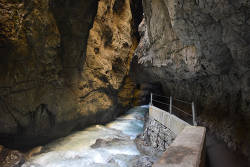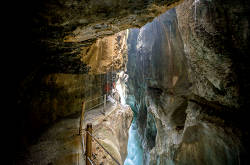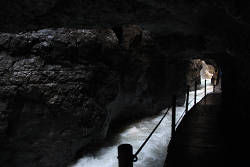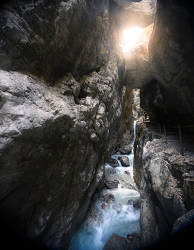Partnachklamm
Useful Information



| Location: |
Wildenau 14, 82467 Garmisch-Partenkirchen.
Near Garmisch-Partenkirchen. From Garmisch B2 towards Mittenwald, at city limits turn right. Parking at Olympia-Skistadion. 25 min walk to the entrance, or use horse carriage. (47.469128, 11.119339) |
| Open: |
JUN to SEP daily 8-20. OCT to MAY daily 8-18. Temporary closures for necessary renovation works during spring weather possible. [2024] |
| Fee: |
Adults EUR 10, Children (6-17) EUR 5, Children (0-5) free, GuestCard EUR 9, Locals EUR 8.50, Disabled EUR 5, Dogs EUR 5. Groups (15+): Adults EUR 9, Children (6-17) EUR 4. Online booking available. [2024] |
| Classification: |
 Gorge Gorge
|
| Light: | n/a |
| Dimension: | L=700 m, D=86 m, VR=80 m. |
| Guided tours: |
self guided.
V=200,000/a [2010] |
| Photography: | allowed, no drones |
| Accessibility: | no |
| Bibliography: | |
| Address: |
Partnachklamm, Eingangshütte, Wildenau 14, 82467 Garmisch-Partenkirchen, Tel: +49-8821-3167.
E-mail: Tourist Information, Garmisch-Partenkirchen, Tel: +49-8821-180-700. E-mail: |
| As far as we know this information was accurate when it was published (see years in brackets), but may have changed since then. Please check rates and details directly with the companies in question if you need more recent info. |
|
History
| 1820 | Josef Naus has to bypass the gorge during the first ascent of the Zugspitze. |
| 1860s | Reintal and its side valleys are opened up by large forest roads on which the timber can be safely transported. |
| 1885 | a devastating windthrow in the forests blocks the forest roads. |
| 1886 | makeshift drift path built through the gorge. |
| 1910-1912 | construction of a path through the gorge for tourism. |
| 1912 | declared a Natural Monument. |
| 1930 | improvement of the path, the gorge is also accessible in winter. |
| 1949 | project for a dam in the Partnach Gorge meets with massive resistance and is never realized. |
| 01-JUN-1991 | landslide of 5000 m³ of rock at the southern end of the gorge, creating a small lake. |
| 1992 | a 108-metre-long tunnel allows the landslide to be bypassed. |
| 2006 | declared a national geosite. |
Description






The Partnachklamm (Partnach Gorge) is about 700 m long with 80 m high vertical walls. The wild river Partnach rushes down the gorge deepening it day by day, but especially in spring with the huge amounts of melting water from the mountains. The trails are cut into the walls, high above the river, so the gorge is open all year. Only in spring it has to be closed sometimes, because of dangerous melting water floods or necessary repair works. In winter the gorge has a special feature, strange ice formations created by freezing water emerging from small springs in the cliff face. The gorge is very popular, it is visited by some 200,000 people per year.
The Partnach is the meltwater of the Schneeferner, a glacier on the Zugspitzplatt. This flows underground through the karst to its source in the Reintal, flows through the valley and plunges down the Partnach Falls, then disappears underground again for a few hundred metres. However, this is not karst, but a landslide, with the Partnach flowing through the spaces in between the scree. The stream then flows through two gorges, the Hinterklamm and the Mittelklamm, neither of which is accessible. It receives more water through an inflow and then flows through the actual Partnach Gorge.
The high valleys of the Alps were not utilized economically for a long time, as they were very difficult to access and there were climatic restrictions. However, in the 19th century, many of the forests began to be utilized by clearing. The bishops of Freising authorized the extraction of firewood and timber from the Ferchental, Reintal and Stuiben areas. However, felling the trees was the minor problem; transporting them was the real hurdle. Normally, the wood was transported on horse-drawn sleighs, so the so-called Bergholz (mountain wood) was transported in winter when there was snow. The only other option was to transport it in a stream. This was the so-called Wasserholz (water wood), which was transported in spring when the streams had the most water. The wood was sawn to a length of 1 metre and simply thrown into the stream. On the one hand, the water did the work, but on the other hand it was much more dangerous if the logs were pushed up against the rocks or wedged into each other. The woodcutters then had to loosen the logs again with a so-called Grieshaken, a life-threatening job. As the gorge was not accessible at the time, they were lowered down from the edge of the gorge on a rope to which a seat with a roof was attached. The roof served as protection against falling rocks.
In many gorges in the Alps, drifting was the trigger for the construction of drift paths, which made the gorges accessible. This did not apply to the Partnach Gorge; the Reintal and its side valleys had already been opened up by large forest roads in the 1860s, on which the timber could be transported much more safely. However, in 1885 there was a devastating windthrow in the forests, and it was impossible to get through, so they had to switch back to the triften. In 1886, a makeshift passage through the gorge was created by attaching iron girders to the rock face above the stream and covering them with wooden planks. Lumberjacks stood on this footbridge and steered the wood with their Grieshaken. This path was subsequently used by hunters and forestry workers, but more and more adventurous tourists also visited the gorge. The Partnach Gorge was finally opened up for tourism between 1910 and 1912. A new path was built for this purpose, which was significantly higher and better protected against flooding - the financial outlay was enormous. When it was opened, the gorge was declared a natural monument. Improvements to the trail in 1930 finally made it accessible in winter too.
In 1949, a plan was drawn up to close the Partnach Gorge with a 110-metre-high dam. This is technically relatively simple due to the narrow width. The entire Reintal and Ferchenbachtal valleys would have been filled with water, creating a huge reservoir that would have been used to generate hydroelectricity in Wildenau. There was massive opposition to the project and it was never realized.
The most spectacular event in the history of the gorge was probably the landslide on 01-JUN-1991. 5000 m³ of rock broke out of the rock face at the southern end of the gorge and blocked the gorge, creating a small lake. In 1992, a 108-metre-long tunnel was opened, which was blasted through the rock to bypass the landslide. A window also allows a safe view of the spectacular landslide.
The last improvement to the trail took place in 2020, presumably to take advantage of the low visitor numbers during the pandemic. One narrow section was widened to double its width and now allows two-way traffic. Various rope railings were fitted with nets. Emergency call pillars and 26 lamps increase safety, as do the motion sensors that were installed in cooperation with the Technical University of Munich. But the pandemic has also had another impact: there is now an online booking system. One particular restriction: there is no mobile phone reception at the gorge, so the barcode must be downloaded in advance. It is very convenient that the ticket can be used once not only on the day booked, but also within the following 4 days. This is probably unique.
The Partnachklamm gorge has been the start of the ascent to the Zugspitze since it was extended, the standard route so to speak. This was not the case when the Zugspitze was first climbed; Josef Naus had to bypass the gorge in 1820. However, although the gorge has huge numbers of visitors, the valley narrows before the gorge and there is no room for a car park. For this reason, the paid car park at the Olympic Stadium is the official car park for the gorge. The website talks about a pleasant 25-minute walk to the gorge, which is a 2.2-kilometre walk on a tarred road. And on busy days, the car park is quickly full, and you have to switch to car parks further away. There used to be the option of travelling by horse-drawn carriage in the high season, for a fee of course. We are not sure if it is still available. Unfortunately, we have noticed a considerable inflation in many sights over the last 10 years. Unfortunately, the Partnachklamm gorge is one of the frontrunners: prices have more than tripled. In addition, there is a paid car park and other charges. Since 2017, it is no longer possible to cross the gorge outside the opening hours, forcing mountaineers to bypass it again. Although the gorge is certainly worth a visit, there are so many other gorges in the Alps, even on the German side, that we recommend visiting one of the others. The other gorges are equally spectacular, easier to access, less crowded and much cheaper.


 Search DuckDuckGo for "Partnachklamm"
Search DuckDuckGo for "Partnachklamm" Google Earth Placemark
Google Earth Placemark OpenStreetMap
OpenStreetMap Partnach Gorge - Wikipedia (visited: 16-AUG-2024)
Partnach Gorge - Wikipedia (visited: 16-AUG-2024) PARTNACH GORGE IN GARMISCH-PARTENKIRCHEN, official website (visited: 16-AUG-2024)
PARTNACH GORGE IN GARMISCH-PARTENKIRCHEN, official website (visited: 16-AUG-2024)
 Index
Index Topics
Topics Hierarchical
Hierarchical Countries
Countries Maps
Maps